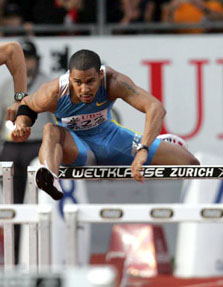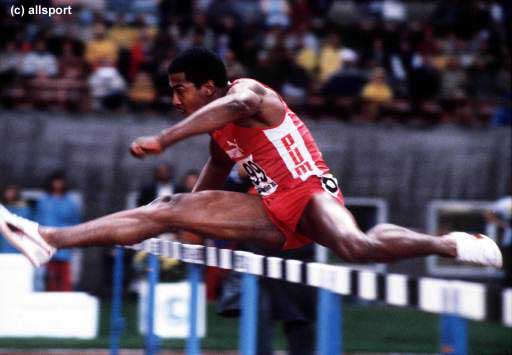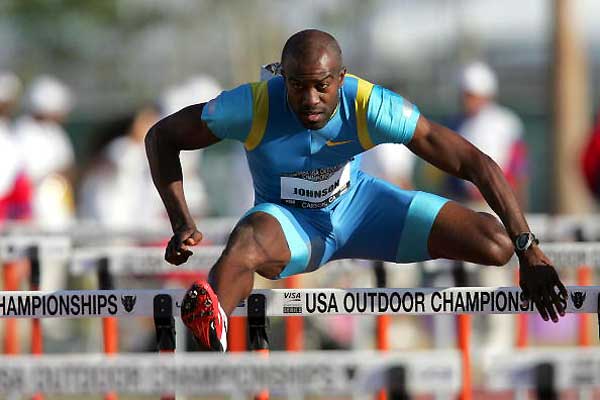Keep Your Head Up
One mistake that many hurdlers make has to do with how they hold their heads during hurdle clearance. Most hurdlers, it seems, bring their head down so that the dome of their head is facing the next hurdle, and their eyes are looking down, facing the track. In fact, there should be very little, if any, movement of the head at all. Ideally, even when clearing 42-inch hurdles, you want to be able to focus your eyes on the next hurdle while you’re still in the process of negotiating the barrier that you’re currently clearing.
Like the knee of the lead leg, the head is important for balance purposes while clearing a hurdle. If the head shifts to the left or the right, your weight will shift in the same direction, causing you to run the entire race, basically, hugging the edge of the lane instead of running smoothly down the middle of the lane. Jerking the head in either direction will also cause the arms to swing across the body to an exaggerated degree.
All hurdlers want to lean, or buck, while going over a hurdle. But what does this mean? When we say “lean” in hurdling, that word is often misinterpreted to mean lean forward, which is not what it means at all. When you lean forward, your head comes down, you become top-heavy, and you stumble when you land. Even if you’re strong enough that you don’t lose balance, you’re still going to lose time, because it takes time to lean forward during hurdle clearance, and to then return to upright position upon landing. What you really want to do, for lack of better phrasing, is lean downward. You’re staying erect from the waist up, crouching downward from the lower back and abdominal region, but keeping your chin straight, keeping your eyes on the crossbar of the next hurdle. It takes a significant amount of groin and hip flexibility, as well as abdominal strength, to hurdle this way, but it the only way to hurdle in a way that is fluid, without either leg being forced to wait on the other.

Ron Bramlett, on the right, hurdles with the upper-body balance that enables him to maintain a fluid rhythm.
The thing about leaning forward that makes it attractive, and habitual, is that it does enable you to get the height you need to clear the hurdle without hitting it, especially if you’re someone who locks the lead-leg knee. But it also causes you to elevate during take-off, because it does not raise your center of gravity. Therefore, the only way to raise your center of gravity is to take off on a more vertical angle than would be most efficient. So, how to keep the head straight, the chin up, yet still get the necessary height to clear the hurdle with jumping? By rolling the hips forward and upward, as if they’re on wheels, during take-off. This tactic will give you the feeling of looking down on the hurdle. Also, your lead leg knee will have more room to do what it wants to do, which is to drive as close to straight-up and straight-down as possible, or, in other words, to stay as close to natural sprinting motion as possible.
Of all the factors that made Renaldo Nehemiah’s hurdling style appear so abnormally graceful, the one that, to me, stands out the most, is the fact that he was able to clear 42-inch obstacles while basically remaining in an upright position, with his chin up, with his eyes facing the next hurdle. That’s the quality that made his races appear so fluid, graceful, and seamless. A lot of hurdlers, when trying to get over hurdles without bringing their heads down, will tilt their bodies to the lead-leg side of the lane, the reason being that they are not flexible enough in the groin area – neither the lead-leg nor the trail-leg side, to negotiate the barrier while keeping the head up.

Renaldo Nehemiah exhibits the upright torso, chin, and forehead that allowed him to make hurdling look so easy.
To me, the chin is a very trustworthy barometer by which to gauge a hurdler’s balance. The power hurdlers who bull-doze hurdles have problems with balance for the simple fact that they can’t see where they’re going! And also because the force of propelling themselves forward creates too violent a shift in their center of gravity. Allen Johnson, the greatest hurdler of the modern era, hits a lot of hurdles, yet he is very fluid and rhythmic. I would argue that the difference between the AJ races in which he hits a lot of hurdles and the ones in which he skims right over the crossbar is the positioning of his chin during hurdle clearance. In his cleaner races, he keeps his chin up much more consistently. When he is hitting a lot of hurdles, his chin tends to duck down.

When AJ keeps his head up, he doesn’t hit hurdles.
You could argue that this argument about keeping the chin up is an argument of aesthetics, and, to a degree, you may have a point. There are plenty of hurdlers whose foreheads almost touch their lead-leg knee during hurdle clearance, yet they hurdle quite effectively and run fast times. But ultimately, time is being lost on the watch. When the head ducks down, the lead leg pauses, and cannot snap down as quickly as it could if the chin stayed up and the torso remained upright.
Think of it this way: does bringing your head down and looking downward with your eyes help you to sprint faster when there aren’t any hurdles in your way? No, it slows you down. So, the same principle applies when the hurdles are in the way.
© 2005 Steve McGill
